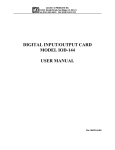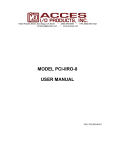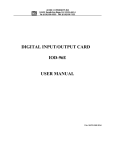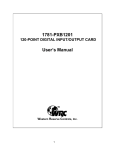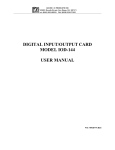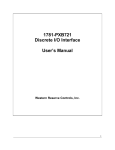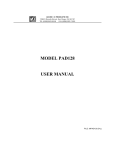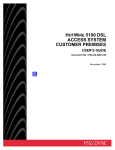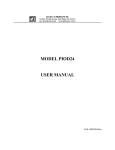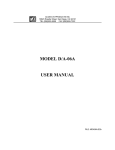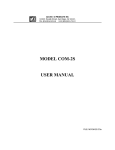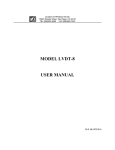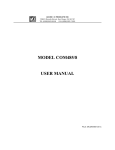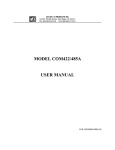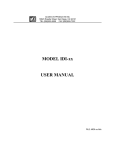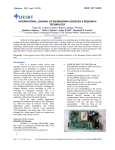Download IOD-72 Manual - ACCES I/O Products
Transcript
ACCES I/O PRODUCTS INC
10623, Roselle Street, San Diego, CA 92121
Tel. (619)550-9559 FAX (619)550-7322
DIGITAL INPUT/OUTPUT CARD
IOD-72
USER MANUAL
File: MIOD-72.D2
DIGITAL INPUT/OUTPUT CARD
IOD-72 Rev D
USER MANUAL
NOTICES
The information in this document is provided for reference only. ACCES does not assume
any liability arising out of the application or use of the information or products described
herein. This document may contain or reference information and products protected by
copyrights or patents and does not convey any license under the patent rights of ACCES,
nor the rights of others.
IBM PC, PC/XT, and PC/AT are registered trademarks of the International Business
Machines Corporation.
Printed in USA. Copyright 1995 by ACCES I/O PRODUCTS INC, 10623 Roselle Street,
San Diego, CA 92121. All rights reserved.
i
DIGITAL INPUT/OUTPUT CARD
IOD-72 Rev D
USER MANUAL
TABLE OF CONTENTS
INSTALLATION . . . . . . . . . . . . . . . . . . . . . . . . . . . . . . . . . . . . . . .
CD INSTALLATION . . . . . . . . . . . . . . . . . . . . . . . . . . . . . . . . .
3.5-INCH DISKETTE INSTALLATION . . . . . . . . . . . . . . . . . . .
DIRECTORIES CREATED ON THE HARD DISK . . . . . . . . . .
INSTALLING THE CARD . . . . . . . . . . . . . . . . . . . . . . . . . . . .
1-1
1-1
1-1
1-2
1-5
FUNCTIONAL DESCRIPTION . . . . . . . . . . . . . . . . . . . . . . . . . . . .
FEATURES . . . . . . . . . . . . . . . . . . . . . . . . . . . . . . . . . . . . . . .
APPLICATIONS . . . . . . . . . . . . . . . . . . . . . . . . . . . . . . . . . . . .
DESCRIPTION . . . . . . . . . . . . . . . . . . . . . . . . . . . . . . . . . . . .
BLOCK DIAGRAM . . . . . . . . . . . . . . . . . . . . . . . . . . . . . . . . . .
2-1
2-1
2-1
2-1
2-2
OPTION SELECTION . . . . . . . . . . . . . . . . . . . . . . . . . . . . . . . . . . . 3-1
OPTION SELECTION MAP . . . . . . . . . . . . . . . . . . . . . . . . . . . 3-2
ADDRESS SELECTION . . . . . . . . . . . . . . . . . . . . . . . . . . . . . . . . . 4-1
ADDRESS ASSIGNMENTS FOR PC AND PC/XT . . . . . . . . . . 4-1
ADDRESS ASSIGNMENTS FOR 286/386/486 . . . . . . . . . . . . 4-2
SOFTWARE . . . . . . . . . . . . . . . . . . . . . . . . . . . . . . . . . . . . . . . . . . 5-1
SET . . . . . . . . . . . . . . . . . . . . . . . . . . . . . . . . . . . . . . . . . . . . . 5-1
PROGRAMMING . . . . . . . . . . . . . . . . . . . . . . . . . . . . . . . . . . . . . .
ADDRESS SELECTION TABLE . . . . . . . . . . . . . . . . . . . . . . .
PPI CONTROL REGISTER BIT ASSIGNMENTS . . . . . . . . . .
PROGRAMMING EXAMPLE . . . . . . . . . . . . . . . . . . . . . . . . . .
SAMPLE PROGRAMS . . . . . . . . . . . . . . . . . . . . . . . . . . . . . .
TURBO PASCAL PROGRAM . . . . . . . . . . . . . . . . . . .
TURBO-C PROGRAM . . . . . . . . . . . . . . . . . . . . . . . . .
6-1
6-1
6-2
6-3
6-4
6-4
6-7
CONNECTOR PIN ASSIGNMENTS . . . . . . . . . . . . . . . . . . . . . . . . 7-1
SPECIFICATION . . . . . . . . . . . . . . . . . . . . . . . . . . . . . . . . . . . . . . . 8-1
WARRANTY . . . . . . . . . . . . . . . . . . . . . . . . . . . . . . . . . . . . . . . . . . 9-1
APPENDIX A . . . . . . . . . . . . . . . . . . . . . . . . . . . . . . . . . . . . . . . . . . A-1
PROGRAMMABLE PERIPHERAL INTERFACE DATA SHEETS A-1
ii
DIGITAL INPUT/OUTPUT CARD
IOD-72 Rev D
USER MANUAL
INSTALLATION
The software provided with this card is contained on either one CD or multiple diskettes
and must be installed onto your hard disk prior to use. To do this, perform the following
steps as appropriate for your software format and operating system. Substitute the
appropriate drive letter for your CD-ROM or disk drive where you see d: or a:
respectively in the examples below.
CD INSTALLATION
DOS/WIN3.x
1. Place the CD into your CD-ROM drive.
2. Type d:K to change the active drive to the CD-ROM
drive.
3. Type installK to run the install program.
4. Follow the on-screen prompts to install the software for
this card.
WIN95/98/NT
1. Place the CD into your CD-ROM drive.
2. The CD should automatically run the install program after 30 seconds.
If the install program does not run, click START | RUN and type
d:install, click OK or press K.
3. Follow the on-screen prompts to install the software for this card.
4. Click the “Go to ACCES Web” button to check for software updates.
3.5-INCH DISKETTE INSTALLATION
As with any software package, you should make backup copies for everyday use and store
your original master diskettes in a safe location. The easiest way to make a backup copy
is to use the DOS DISKCOPY utility.
In a single-drive system, the command is:
diskcopy a: a:K
You will need to swap disks as requested by the system.
In a two-disk system, the command is:
diskcopy a: b:K
1-1
DIGITAL INPUT/OUTPUT CARD
IOD-72 Rev D
USER MANUAL
This will copy the contents of the master disk in drive A to the backup disk in drive B.
To copy the files on the master diskette to your hard disk, perform the following steps.
1.
Place the master diskette into a floppy drive
2. Change the active drive to the drive that has the diskette installed. For
example, if the diskette is in drive A, type a:K.
3. Type installK and follow the on-screen prompts.
DIRECTORIES CREATED ON THE HARD DISK
The installation process will create several directories on your hard disk. If you accept the
installation defaults, the following structure will exist.
[CARDNAME]
Root or base directory containing the SETUP.EXE setup program used
to help you configure jumpers and calibrate the card.
DOS\PSAMPLES:
A subdirectory of
samples.
[CARDNAME] that contains Pascal
DOS\CSAMPLES:
A subdirectory of [CARDNAME] that contains “C” samples.
WIN32\language
Subdirectories containing samples for Win95/98 and NT.
WinRisc.exe: A Windows dumb-terminal type communication program
designed for RS422/485 operation. Used primarily with REMOTE
ACCES Data Acquisition Pods and our RS422/485 serial
communication product line. Can be used to say hello to an
installed modem.
ACCES32:
This directory contains the Windows 95/98/NT driver used to
provide access to the hardware registers when writing 32-bit
Windows software. Several samples are provided in a variety of
languages to demonstrate how to use this driver. The DLL
provides four functions (InPortB, OutPortB, InPort, and OutPort)
to access the hardware.
This directory also contains the device driver for Windows NT,
ACCESNT.SYS. This device driver provides register-level hardware
access in Windows NT. Two methods of using the driver are available,
through ACCES32.DLL (recommended) and through the
DeviceIOControl handles provided by ACCESNT.SYS (slightly faster).
SAMPLES: Samples for using ACCES32.DLL are provided in this
directory. Using this DLL not only makes the hardware
1-2
DIGITAL INPUT/OUTPUT CARD
IOD-72 Rev D
USER MANUAL
programming easier (MUCH easier), but also one source
file can be used for both Windows 95/98 and WindowsNT.
One executable can run under both operating systems and
still have full access to the hardware registers. The DLL
is used exactly like any other DLL, so it is compatible with
any language capable of using 32-bit DLLs. Consult the
manuals provided with your language’s compiler for
information on using DLLs in your specific environment.
VBACCES:
PCI:
This directory contains sixteen-bit DLL drivers for use with
VisualBASIC 3.0 and Windows 3.1 only. These drivers
provide four functions, similar to the ACCES32.DLL.
However, this DLL is only compatible with 16-bit
executables. Migration from 16-bit to 32-bit is simplified
because of the similarity between VBACCES and
ACCES32.
This directory contains PCI-bus specific programs and
information. If you are not using an ACCES PCI card, this
directory will not be installed.
SOURCE:
A utility program is provided with source code you can use
to determine allocated resources at run-time from your
own programs in DOS.
PCIFind.exe A utility for DOS and Windows to determine what base
address and IRQ are allocated to installed PCI cards. This
program runs two versions, depending on the operating
system. Windows 95/98/NT displays a GUI interface, and
modifies the registry. When run from DOS or Windows3.x,
a text interface is used. For information about the format
of the registry key, consult the card-specific samples
provided with the hardware.
In Windows NT,
NTioPCI.SYS runs each time the computer is booted,
thereby refreshing the registry as PCI hardware is added
or removed. In Windows 95/98/NT PCIFind.EXE places
itself in the boot-sequence of the OS to refresh the registry
on each power-up.
This program also provides some COM configuration
when used with PCI COM ports. Specifically, it will
configure compatible COM cards for IRQ sharing and
multiple port issues.
1-3
DIGITAL INPUT/OUTPUT CARD
WIN32IRQ:
IOD-72 Rev D
USER MANUAL
This directory provides a generic interface for IRQ handling in
Windows 95/98/NT. Source code is provided for the driver,
greatly simplifying the creation of custom drivers for specific
needs. Samples are provided to demonstrate the use of the
generic driver. Note that the use of IRQs in near-real-time data
acquisition programs requires multi-threaded application
programming techniques and must be considered an intermediate
to advanced programming topic. Delphi, C++ Builder, and
Visual C++ samples are provided.
Findbase.exe
DOS utility to determine an available base address for ISA bus , nonPlug-n-Play cards. Run this program once, before the hardware is
installed in the computer, to determine an available address to give the
card. Once the address has been determined, run the setup program
provided with the hardware to see instructions on setting the address
switch and various option selections.
Poly.exe
A generic utility to convert a table of data into an nth order polynomial.
Useful for calculating linearization polynomial coefficients for
thermocouples and other non-linear sensors.
Risc.bat
A batch file demonstrating the command line parameters of
RISCTerm.exe.
RISCTerm.exe
A dumb-terminal type communication program designed for RS422/485
operation. Used primarily with REMOTE ACCES Data Acquisition Pods
and our RS422/485 serial communication product line. Can be used to
say hello to an installed modem. RISCTerm stands for Really Incredibly
Simple Communications TERMinal.
INSTALLING THE CARD
Before installing the card carefully read the ADDRESS SELECTION and OPTION
SELECTION Sections of this manual and configure the card according to your requirements. Use the special software program called SETUP provided with the card. It
supplies visual aids to configure all areas of the board.
Be especially careful with address selection. If the addresses of two installed functions
overlap, you will experience unpredictable computer behavior. If unsure what locations are
available, you can use the FINDBASE program to locate blocks of available addresses.
1-4
DIGITAL INPUT/OUTPUT CARD
IOD-72 Rev D
USER MANUAL
To install the card:
1.
2.
3.
4.
5.
6.
7.
8.
9.
10.
11.
Remove power from the computer.
Remove the computer cover.
Remove blank I/O backplate.
Install jumpers for selected options. See OPTION SELECTION section
of this manual.
Select the base address on the card. See ADDRESS SELECTION
section of this manual.
Loosen the nuts on the strain relief bar and swing top end free.
Install the card in an I/O expansion slot. If convenient, select a slot
which is adjacent to a vacant slot because this will make cable
installation easier.
Thread the I/O cables, one by one, through the cutout in the mounting
bracket and plug them into the headers.
Smooth the cables as close as possible to the card and, while holding
them close to the surface of the card, swing the strain relief bar into
position and tighten nuts.
Inspect for proper fit of the card and cables and tighten screws.
Replace the computer cover.
Input/Output cable connections are via two 50-pin headers on the card. A blank mounting
bracket is provided with units marked for CE (European) Certification and, for these units,
CE-certifiable cable and break-out methodology (cables connect to chassis ground at the
aperture, shielded twisted pair wiring, etc.) must be used. Also, it is important that the card
bracket be properly screwed in place and that there be a positive chassis ground.
1-5
DIGITAL INPUT/OUTPUT CARD
IOD-72 Rev D
USER MANUAL
FUNCTIONAL DESCRIPTION
FEATURES
72 Channels of Digital Input/Output.
All 72 I/O Lines Buffered on the Board.
Four and Eight Bit Groups Independently Selectable for I/O.
Hysteresis correction and Pull-Ups on I/O Lines.
Interrupt and Interrupt-Disable Capability.
+5V Supply Available to the User.
Compatible with Industry-Standard I/O Racks like Opto-22, Potter & Brumfield, etc.
APPLICATIONS
Automatic Test Systems.
Robotics
Security Systems, Energy Management.
Relay Monitoring and Control.
Parallel Data Transfer to PC.
Sensing Switch Closures or TTL, DTL, CMOS Logic
Driving Indicator Lights or Recorders
DESCRIPTION
The IOD-72 Board was designed for industrial applications and can be installed in any I/O
slot of an IBM PC/XT/AT or compatible computer. Each I/O line is buffered and capable
of sourcing 15 mA or sinking 24mA (64 mA on request). The card contains three
Programmable Peripheral Interface chips type 8255-5 (PPI) to provide computer interface
to 72 I/O lines. Each PPI provides three 8-bit ports A, B, and C. Each 8-bit port can be
software configured to function as either inputs or output latches. Port C can also be
configured as four inputs and four output latches. The I/O line buffers (74LS245) are
configured automatically by hardware logic for input or output use according to direction
assignment from a control register in the PPI.
Two I/O lines of each port can be used to interface User Interrupts to the computer.
Interrupts are buffered and are enabled by jumper installation or by a combination of
jumper installation and a digital input line. You can use Interrupts #2 through #7, #10
through #12, #14 and #15. Interrupts of all ports (one per port) are OR'ed together.
I/O wiring connections are via 50-pin headers on the board. Three flat I/O cables connect
IOD-72 to termination panels such as ACCES' model STA-50. Also, this provides
compatibility with OPTO-22, Gordos, Potter & Brumfield, etc. module mounting racks.
Every second conductor of the flat cables is grounded to minimize the effect of crosstalk
2-1
DIGITAL INPUT/OUTPUT CARD
IOD-72 Rev D
USER MANUAL
between signals. If needed for external circuits, +5 VDC power is available on each I/O
connector pin 49. If you use this power, we recommend that you include a 1A fast-blow
fuse in your circuits in order to avoid possible damage to the host computer in the event
of a malfunction in those external circuits.
The IOD-72 occupies sixteen bytes of I/O address space. The base address is selectable
via a DIP switch anywhere within the range of 000-3FF hex. If in doubt how to select a
base address, check your computer Reference Manual. For additional information about
setting the base address of IOD-72, see section 4 of this manual.
Utility software provided with the IOD-72 card is an illustrated setup program. Interactive
displays show locations and proper settings of DIP switches and jumpers to set up board
address, interrupt levels, and interrupt enable. Also, sample programs in Turbo-C and
Turbo-Pascal are presented in section 5 of this manual.
IOD-72 BLOCK DIAGRAM
Typical of three sections
2-2
DIGITAL INPUT/OUTPUT CARD
IOD-72 Rev D
USER MANUAL
OPTION SELECTION
Refer to the setup programs on the CD provided with the card. Also, refer to the IOD-72
Card BLOCK DIAGRAM on the previous pages and the OPTION SELECTION MAP on the
following page when reading this section of the manual.
Board Address selection is covered both by the setup program and by section 4 of this
manual.
Interrupts are accepted on the I/O connector pin 9 (port C3). The Interrupt signal is positive
true. Interrupts are enabled if the IEN jumper is installed or if the IP jumper is installed and
the C7 I/O line (connector pin 1) is held low. Interrupts are disabled if neither the IEN or
IP jumpers are installed or if the IP jumper is installed but the C7 I/O line is high. Interrupts
are directed to levels #2 through #7, #10 through #12, #14, and #15 by jumpers installed
at locations labeled IRQ2 through IRQ15.
The foregoing are the only manual setups necessary to use the IOD-72. Input/Output
selection is done via software by writing to a control register in each PPI as described in
the PROGRAMMING section of this manual.
3-1
DIGITAL INPUT/OUTPUT CARD
IOD-72 Rev D
IOD-72 OPTION SELECTION MAP
3-2
USER MANUAL
DIGITAL INPUT/OUTPUT CARD
IOD-72 Rev D
USER MANUAL
ADDRESS SELECTION
The IOD-72 Input/Output Card occupies 16 bytes of I/O space. The card base address can
be selected anywhere within an I/O address range 100-3F0 hex in AT's (except 1F0 to
1F8) and 200-3F0 in XT's. However two installed cards cannot share the same address.
If in doubt where to assign the base address of the IOD-72, refer to the following tables
and the FINDBASE program to find an available address in your system.
STANDARD ADDRESS ASSIGNMENTS FOR PC AND PC/XT COMPUTERS
Hex Range
000-00F
020-021
040-043
060-063
080-083
0AX
0CX
0EX
100-1FF
200-20F
210-217
220-24F
278-27F
2F0-2F7
2F8-2FF
300-31F
320-32F
378-37F
380-38C**
380-389**
3A0-3A9
3B0-3BF
3C0-3CF
3D0-3DF
3E0-3E7
3F0-3F7
3F8-3FF
Usage
DMA Chip 8237A-5
Interrupt 8259A
Timer 8253-5
PPI 8255A-5
DMA Page Register
NMI Mask Register
Reserved
Reserved
Not usable
Game Control
Expansion Unit
Reserved
Reserved
Reserved
Asynchronous Comm'n (Secondary)
Prototype Card
Fixed Disk
Printer
SDLC Communications
Binary Synchronous Comm. (Secondary)
Binary Synchronous Comm. (Primary)
IBM Monochrome Display/Printer
Reserved
Color/Graphics
Reserved
Diskette
Asynchronous Comm'n. (Primary)
** These options can not be used together - addresses overlap
4-1
DIGITAL INPUT/OUTPUT CARD
IOD-72 Rev D
USER MANUAL
STANDARD ADDRESS ASSIGNMENTS FOR 286/386/486 COMPUTERS
Hex Range
Usage
000-01F
020-03F
040-05F
060-06F
070-07F
080-09F
0A0-0BF
0C0-0DF
0F0
0F1
0F8-0FF
1F0-1F8
200-207
278-27F
2F8-2FF
300-31F
360-36F
378-37F
380-38F
3A0-3AF
3B0-3BF
3C0-3CE
3D0-3DF
3F0-3F7
3F8-3FF
DMA Controller 1
INT Controller 1, Master
Timer
8042 (Keyboard)
Real Time Clock, NMI Mask
DMA Page Register
INT Controller 2
DMA Controller 2
Clear Math Coprocessor Busy
Reset Coprocessor
Arithmetic Processor
Fixed Disk
Game I/O
Parallel Printer Port 2
Asynchronous Comm'n (Secondary)
Prototype Card
Reserved
Parallel Printer Port 1
SDLC or Binary Synchronous Comm'n 2
Binary Synchronous Comm'n 1
Monochrome Display/Printer
Local Area Network
Color/Graphic Monitor
Floppy Diskette Controller
Asynchronous Comm'n (Primary)
To set a desired board address , refer to the illustrated Board Address setup program
provided with the card. Type the desired address in hexadecimal code and the graphic
display shows you how to set the ADDRESS SETUP switches. These switches are marked
A4-A9 and form a binary representation of the address in negative-true logic. (Assign '0'
to all ADDRESS SETUP switches turned ON, and assign '1' to all ADDRESS SETUP
switches turned OFF.)
Switch Identification
A9
A8
A7
A6
A5
A4
Address Line Controlled
A9
A8
A7
A6
A5
A4
The following example illustrates switch selection corresponding to hex 2D0 (or binary 10
1101 xxxx). The "xxxx" represents address lines A3, A2, A1, and A0 used on the Card to
select individual registers at the PPI's. See Section 5, PROGRAMMING.
4-2
DIGITAL INPUT/OUTPUT CARD
IOD-72 Rev D
Hex Representation
USER MANUAL
2
D
Conversion Multipliers
2
1
8
4
2
1
Binary Representation
1
0
1
1
0
1
OFF
ON
OFF
OFF
ON
OFF
A9
A8
A7
A6
A5
A4
Setup
Switch ID
CAUTION
Carefully review the address selection reference
table on the previous page before selecting the
card address. If the addresses of two installed
functions overlap you will experience unpredictable
computer behavior.
4-3
DIGITAL INPUT/OUTPUT CARD
IOD-72 Rev D
USER MANUAL
SOFTWARE
ACCES supplies several programs to support the IOD-72 Digital I/O card and, also, to help
you develop your applications software. These programs are on a CD that comes with
your card and consist of a Setup program and sample programs. The sample programs are
in forms suitable for use with BASIC, QuickBASIC, C, and Pascal.
The programs as follows:
FINDBASE: Program locates active and available port addresses.
SETUP:
IOD-120 Board Setup Program
BSAMPLES: SAMPLE1
SAMPLE2
CSAMPLES: SAMPLE1
A Quickbasic program that writes a sequence of
values to Port A and reads and displays the values
in Ports A & B.
A Quickbasic program that displays the bits in Ports
A & B and, when an interrupt occurs, polls those
same bits.
A “C” program that writes a sequence of values to
Port A and reads and displays the values in Ports
A & B.
SAMPLE2
A "C" program that displays the bits in Ports A & B and,
when an interrupt occurs, polls those same bits.
PSAMPLES: SAMPLE1
A “Pascal” program that writes a sequence of
values to Port A and reads and displays the values
in Ports A & B.
SETUP
This program is supplied with the IOD-72 card as a tool for you to use in configuring
jumpers and switches on the card. It is menu-driven and provides pictures of the card on
the computer monitor. You make simple keystrokes to select the functions. In turn, the
pictures then change to show how the jumpers or switches should be placed to effect your
choices.
The setup program is a stand-alone program that can be run at any time. It does not
require the IOD-72 to be plugged into the computer for any part of the setup. The program
is self-explanatory with operation instructions and on-line help.
5-1
DIGITAL INPUT/OUTPUT CARD
IOD-72 Rev D
USER MANUAL
PROGRAMMING
The IOD-72 is an I/O mapped device that is easily configured from any language and any
language can easily perform digital I/O through the card's ports. This is especially true if
the form of the data is byte or word wide. All references to the I/O ports would be in
absolute port addressing. However, a table could be used to convert the byte and word
data ports to a logical reference. If you are working with VisualBASIC for Windows, then
the VBACCESS utility provided with your card provides InPort and OutPort capability.
DEVELOPING YOUR APPLICATION SOFTWARE
If you wish to gain a better understanding of the programs listed in the previous section,
then the information in the following paragraphs will be of interest to you. Refer to the data
sheets and 8255-5 specification in Appendix A.
A total of 15 address locations are used by the IOD-72; five for each PPI. The PPI's are
addressed consecutively with Address bits A3 through A0 (See Address Selection, section
4.) as follows:
ADDRESS SELECTION TABLE
Address
Base Address
Base Address +1
Base Address +2
Base Address +3
Base Address +4
Base Address +5
Base Address +6
Base Address +7
Base Address +8
Base Address +9
Base Address +A
Base Address +B
Base Address +C
Base Address +D
Base Address +E
Port Assignment
PA Port 0
PB Port 0
PC Port 0
Control Group 0
PA Port 1
PB Port 1
PC Port 1
Control Group 1
PA Port 2
PB Port 2
PB Port 2
Control Group 2
Enable/Disable Buffer, Grp 0
Enable/Disable Buffer, Grp 1
Enable/Disable Buffer, Grp 2
Operation
Read/Write
Read/Write
Read/Write
Write Only
Read/Write
Read/Write
Read/Write
Write Only
Read/Write
Read/Write
Read/Write
Write Only
Write Only
Write Only
Write Only
The IOD-72 card uses three 8255-5 PPI's to provide a total of 72 bits input/output capability.
The card is designed to use each of these PPI's in Mode 0 wherein:
a. There are two 8-bit ports (A and B) and two 4-bit ports (C Hi and C Lo).
b. Any port can be configured as an input or an output.
c. Outputs are latched.
d. Inputs are not latched.
Each PPI contains a control register. This Write-only, 8-bit register is used to set the mode
and direction of the ports. At Power-Up or Reset, all I/O lines are set as inputs. Each PPI
should be configured during initialization by writing to the control registers even if the ports
6-1
DIGITAL INPUT/OUTPUT CARD
IOD-72 Rev D
USER MANUAL
are only going to be used as inputs. Output buffers are automatically set by hardware
according to the control register states. Note that control registers are located at base
address +3, base address +7, and base address +B. Bit assignments in each of these
control registers are as follows:
PPI CONTROL REGISTER BIT ASSIGNMENTS
Bit
D0
D1
D2
D3
D4
D5,D6
D7
Assignment
Function
Port C Lo (C0-C3)
Port B
Mode Selection
Port C Hi (C4-C7)
Port A
Mode Selection
Mode Set Flag
1 = Input, 0 = Output
1 = Input, 0 = Output
1 = Mode 1, 0 = Mode 0
1 = Input, 0 = Output
1 = Input, 0 = Output
01 = Mode 1, 00 = Mode 0
1 = Active
.
Note: Mode 1 cannot be used by the IOD-72 without modification (Consult factory.). Thus,
bits D2, D5, and D6 should always be set to "0" and bit D7 to "1".
Similarly, the Group 1 ports and the Group 2 ports can be enabled via the Control Register
at Base Address +7 and Base Address +B respectively. The following program fragment
in C illustrates the foregoing:
const BASE_ADDRESS 0x300
outportb(BASE_ADDRESS+3,0x89);
outportb(BASE_ADDRESS,0);
outportb(BASE_ADDRESS+1,0);
/*This instruction sets the PPI to Mode 0,
ports A and B as output, and port C as input.
See item b. on the previous page.*/
/*These instructions set the initial state of
ports A and B to all zeroes. Port C is not set
because it is configured as an input. See
item c. on the previous page.*/
6-2
DIGITAL INPUT/OUTPUT CARD
IOD-72 Rev D
USER MANUAL
PROGRAMMING EXAMPLE
The following example in BASIC is provided as a guide to assist you in developing your
working software. In this example, the card base address is 2D0 hex and I/O lines of Port
0 are to be setup as follows:
Port A = Input
Port B = Output
Port C Hi = Input
Port C Lo = Output
The first step is to configure the control register. Configure bits of the control register as:
D7
D6
D5
D4
D3
D2
D1
D0
1
0
0
1
1
0
0
0
|
|
|
|
|
|
|
|
|
|
|
|
|
|
|
|__Port C Lo= output
|
|
|
|
|
|
|
|
|
|
|
|
|
|______ Port B= output
|
|
|
|
|
|
|
|
|
|
|
|___________ Mode 0
|
|
|
|
|
|
|
|
|
|________________ Port C Hi= input
|
|
|
|
|
|
|
|_____________________ Port A= input
|
|
|
|
|
|__________________________ Mode 0
|
|
|
|_______________________________ Mode 0
|
|____________________________________ Active Mode Set
This corresponds to 98 hex. If the card base address is 2D0 hex, use the C command to
write to the control register as follows:
Base=0x2D0;
outportb(Base+3,0x98);
To read the inputs at Port A and the upper nybble of Port C, use the C INPUT command:
x=inportb(Base);
y=inportb(Base+2)/16;
//Read Port A
//Read Port C Hi
x= inportb(Baseaddr);
y= inportb(Baseaddr+2)>>4;
To set outputs high ("1") at Port B and the lower nybble of Port C:
outportb(Base+1,0xFF);
outportbBase+2,0xF);
//Turn on all Port B bits
//Turn on all bits of Port C Lo
6-3
DIGITAL INPUT/OUTPUT CARD
IOD-72 Rev D
USER MANUAL
SAMPLE PROGRAMS
The following sample programs are in TURBO-C and TURBO-PASCAL languages. They
cover a security system that allows you to monitor the status of 16 switches and to
automatically trigger four alarms that can be used to turn on lights, activate a siren, or
send a signal to a silent alarm. The alarm system in this demonstration has four arming
stations which toggle the alarm on or off. These programs are also provided on the CD
that ACCES supplied with your IOD card.
TURBO PASCAL PROGRAM
CONST BASEADDR
CONST ON
CONST OFF
=$300; {declare base address for IOD card}
= 1;
{declare some useful constants}
= 0;
{ "
" " " }
TYPE sensor_array = array[0..15] of integer;
{creates a type of variable used
{for sensor data}
VAR sensors_at_arm : sensor_array;
{bit-by-bit status of sensors when alarm}
{is activated. Used to notify user of}
{open windows, etc}
VAR sensors_now : sensor_now; {bit-by-bit status of sensors at current time. When}
{compared against sensors_at_arm, indicates}
{ break-in if there is a change.}
VAR arming_stations : integer;
{variables representing all four arming stations. If}
VAR old_arming_stations: integer; {value changes toggle alarm on/off}
VAR hour, min, sec, hun : word; {variables used to retrieve time}
VAR key : char;
{useful temporary variable}
VAR i : integer;
{useful temporary variable, used in loops}
VAR j : integer;
{ "
"
"
"
"
" }
procedure initialize_board;
begin
port[BASEADDR+3] :=$93;
{this procedure sets MODE 0 as active and sets} {Port A, B, and C LO
as input and Port C HI as} {output}
{port[X] is Pascal's method of accessing the port memory. This code}
{sets the port memory at address 303 hex, and the control register, to}
{93 hex because the bit pattern to set the desired mode and port}
{designations is 10010011 which equals 93 hex end; procedure}
{initialize_board}
procedure read_sensors(VAR ary:sensor_ary);
VAR tempA : byte;
{this procedure fetches data from Ports VAR tempB : byte; A and B}
{and returns a binary representation of each sensor}
begin
tempA := port[BASEADDR]; {this procedure loads tempA and tempB with corresponding inputs}
{from the IOD card}
tempB := port[BASEADDR+1];
for i := 0 to 7 do begin
if ((tempA shr i) AND ON) > 0 then {this tests to see if bit #i is ON and sets the}
ary[i]:=ON
{corresponding array element to ON}
else
ary[i]:=OFF
{if it is...else, the array element is set to OFF}
end;
for i:=0 to 7 do begin
6-4
DIGITAL INPUT/OUTPUT CARD
IOD-72 Rev D
if ((tempB shr i) AND ON) > 0 then
ary[i+8]:=ON
else
ary[i+8]:=OFF;
end;
end;{procedure read_sensors}
function get_status:integer;
var temp:integer;
begin
temp:=port[BASEADDR+2];
get_status:=temp AND $0F;
end; {function get_arming_status}
procedure ALARM
var temp:longint;
begin
sound(2000);
temp:=0
port[BASEADDR+2]:=$F;
USER MANUAL
{in order to get Port B into array elements 8 thru 15,}
{we add 8 to the bit numbers in the assignment}
{this sets status to the lower nybble of Port}
{C;the half defined by Initialize to be input for}
{four arming switches}
{this starts the computer's speaker as siren for the alarm}
{this sets Port C's lower nybble bits ON }
repeat
arming_stations:=get_status
{this activates four alarm outputs and then}
if arming_stations <> old_arming_stations then {toggles Port C Hi's LSB which}
temp:=2000000000; {disarmed}
{might be used with an external siren}
port[BASEADDR+2]:=port[BASEADDR+2] XOR $10;
temp:=temp+1;
until temp>=2000000000;
nosound;
end; {procedure ALARM}
begin
initialize_board;
clrscr;
gotoxy(5,5);
writeln('This is the IOD card demonstration program. This ');
writeln('program will simulate an alarm system program for ');
writeln('sixteen sensors and four arming stations, along with');
writeln('four separate alarm outputs which could be routed to');
writeln('a siren, lights, silent alarm,etc');
writeln;
writeln('THIS PROGRAM IS INTENDED FOR DEMONSTRATION PURPOSES,');
writeln('ONLY AND IS NOT MEANT TO BE USED AS AN ACTUAL ALARM ');
writeln('SYSTEM.');
writeln;writeln;
writeln('Press any key to begin program.');
key:readkey;
old_arming_stations:=get_status; {this loads the status of the arming switches}
repeat
{at the time the program is first activated. A}
clrscr;
{change in status would indicate arming}
read_sensors(sensors_now);
{this reads the current status of the sensors,}
for i=0 to 15 do begin
{which is then displayed to indicate open windows, etc.}
if sensors_now[i]=OFF
writeln('Sensor #', i, 'is open');
end;
writeln;
writeln('Press ESC to re-scan, RETURN to begin alarm scanning.');
6-5
DIGITAL INPUT/OUTPUT CARD
key:=readkey;
until key=#13;
IOD-72 Rev D
USER MANUAL
{the repeat/until loop gives the user an opportunity}
{to shut open windows or doors, and then re-scan the sensors}
clrscr;
WHILE TRUE do begin
{this WHILE is used to form an infinite loop}
Writeln('Waiting to be armed, or press any key to halt program.');
repeat
{this repeat/until-loop continues until arming}
arming_stations:=get_status; {station status changes, indicating arming or}
if key pressed then halt(1);
{until a key is pressed terminating the program.}
until arming stations <> old arming stations;
sound(900);
{short tone indicating that alarm has been armed}
delay(300);
{ "
"
"
"
"
"
"
"}
nosound;
{ "
"
"
"
"
"
"
"}
writeln('Alarm system will activate in 15 seconds');
read_sensors(sensors_at_arm);
old_arming_stations : get_status;
gettime(hour,min,sec,hun);
{this code reads the system clock for the current}
i:=sec+15;
{time which is used to delay for 15 seconds}
if i > 60 then i :=i-60;
repeat
gettime(hour,min,sec,hun);
until sec = i;
{end of delay loop}
writeln;
writeln('ALARM SYSTEM ACTIVE AND ARMED');
sound(900);
{short tone indicating that alarm is fully activated}
delay(300);
no sound;
j:=0
{the following code compares current status of sensors against status when}
{armed to determine if break-in has occurred..any change indicates break-in}
repeat
read_sensors(sensors_now);
for i:= 1 to 16 do begin
if sensors_now[i-1] <> sensors_at_arm[i-1]then
j:=1;
end;{for}
arming_stations: get_status;
if arming_stations <> old_arming_stations then
j:= -i;
{flag used to signal that alarm is de-activated}
until j <> 0;
if j = -1 then begin
{if j was set to -1 in the above loop, then alarm is}
{de-activated}
gettime(hour,min,sec,hun);
writeln('Alarm deactivated at ', hour,':',min,':',sec);
sound(900);
{the following code chirps the speaker to indicate disarming}
delay(100); nosound;
delay(50); sound(900);
delay(100); nosound;
nosound;
end
{end of disarming routine}
else {if alarm}begin
writeln('Sensor #', j,' has been activated!!');
gettime(hour,min,sec,hun);
writeln('The time of alarm is ',hour,':',min,':',sec);
ALARM;
end;
{else}
6-6
DIGITAL INPUT/OUTPUT CARD
end;
IOD-72 Rev D
{WHILE this "end" sends the program back }
{to wait to be re-armed}
end.
TURBO-C PROGRAM
#define BASEADDR 0x300 /*declare base address for IOD card*/
#define ON
1
/*create useful constant*/
#define OFF
0
/* "
"
" */
#include "stdio.h"
#include "conio.h"
#include "time.h"
#include "dos.h"
int sensors_at_arm[15];
int sensors_now[15];
int arming_stations;
int_old_arming_stations;
char key;
int i;
int j;
/*bit-by-bit status of sensors at current time*/
/*When compared against status of sensors*/
/* at arm, indicates break-in if there is a change.*/
/*variables representing all four arming stations*/
/*If the value changes, toggle alarm ON/OFF.*/
/*useful temporary variable*/
/*useful temporary variable used in loops*/
/*useful temporary variable*/
initialize(){
outportb(BASEADDR+3,0x93);
/*outportb(addr,byte) is C's method of accessing*/
/*port memory. This procedure sets Port A, B, and*/
/*C LO as inputs and Port C HI as outputs.*/
/*Address* 303 hex is the control register. The bit*/
/*pattern needed to set the desired mode and port*/
/*designation is 10010011 = 93 hex*/
} /*procedure initialize*/
read_sensors(int *ary){
unsigned char tempA;
unsigned char tempB;
tempA = inportb(BASEADDR);
tempB = inportb(BASEADDR+1);
for(i-0;i<8;i++){
if((tempA>> i) & ON){
/*this determines if bit #i is on and sets the corre-*/
*ary++=ON;}
/*sponding array element to ON if it is. If not, sets*/
else{
/*sets the array element to OFF */
*ary++=OFF;}
}
for(i=0;i<8;i++){
if((tempB>> i) & ON){
*ary++=ON; }
else
*ary++=OFF; }
}
} /*procedure read_sensors*/
get_status(){
int temp;
6-7
USER MANUAL
DIGITAL INPUT/OUTPUT CARD
temp=inportb(BASEADDR+2);
return temp & 0x0F;
} /*function get_arming_status*/
ALARM(){
long int temp=0;
sound(2000);
outportb(BASEADDR+@,0xF0);
IOD-72 Rev D
USER MANUAL
/*this sets status to the lower half of Port C, the*/
/*half defined in Initialize to be input, for four*/
/*arming switches.*/
/*this starts the computer's speaker*/
/*this sets Port C upper nybble bits*/
/*to ON (1111 binary = F hex).*/
do{
arming_stations=get_status();
/*this activates four alarm outputs and */
if(arming_stations !=old_arming_stations)
/*then toggles Port C Hi LSB which*/
temp=2000000000; /*dis-armed*/
/*maybe used with an ext'l speaker*/
outportb(BASEADDR+2,inportb(BASEADDR+2)^0x10);
}while(temp++ !=2000000000);
nosound();
} /*procedure ALARM*/
main()
{
time_t start;
initialize();
clscr();
goto(5,5);
printf("This IOD-card demonstration program simulates an alarm\n");
printf("system program for 16 sensors, four arming stations and\n");
printf("four separate alarm outputs which could be routed to a\n");
printf("siren, lights, silent alarm, etc.\n");
printf("\n");
printf("THIS PROGRAM IS FOR DEMONSTRATION PURPOSES ONLY, AND\n"
printf("IS NOT MEANT TO BE USED AS AN ACTUAL ALARM SYSTEM.\n");
printf("\n");printf("n");
printf("Press any key to begin program.\n");
key=getch();
old_arming_stations=get_status();
do{
clrscr();
read_sensors(sensors_now);
for(i=0;i<=15;i++){
if (!sensors_now[i]) printf("Sensor #%d %s\n,i,"is open");
}
printf("\n");
printf("Press ESC to re-scan, RETURN to begin alarm scanning.");
key=getch();
}while(key!=13);
clrscr();
for(;;){
/*this creates an infinite loop*/
printf("Waiting to be armed. Press any key to halt program.\n");
do{
arming_stations=get_status();
if(kbhit()) abort(0);
}while(arming_stations== old_arming_stations);
sound(1000); delay(300);
6-8
DIGITAL INPUT/OUTPUT CARD
IOD-72 Rev D
nosound();
printf("Alarm system will activate in 15 seconds");
read_sensors(sensors_at_arm);
old_arming_stations=get_status();
start=time(NULL);
do{
}while(difftime(time(NULL),start) !=15);
printf("\n");
printf("ALARM SYSTEM ACTIVE AND ARMED\n\n");
sound(900); delay(300);
nosound();
j=0;
do{
read_sensors(sensors_now);
for(i=1;i<=16;i++){
if(sensors_now[i-1] !=sensors_at_arm[i-1])
j=i;
} /*for*/
arming_stations = get_status();
if (arming_stations != old_arming_stations)
j=-1
/*flag used to signal alarm is de-activated*/
while(!j);
if(j == -1){
start=time(NULL);
printf("Alarm deactivated at %s,(asctime(gmtime(&start))));
sound(900); delay(300);
nosound(); delay(50);
sound(900); delay(100);
nosound();
} else {
printf("Sensor #%d has been activated!!\n\n",j);
start=time(NULL);
printf("The time of alarm is %s", asctime(gmtime( &start)));
old_arming_stations=get_status();
ALARM();
} /*else*/
} /* for(;;) this "end" used to send program back to await re-arm*/
}
6-9
USER MANUAL
DIGITAL INPUT/OUTPUT CARD
IOD-72 Rev D
USER MANUAL
SHARING INTERRUPTS ON THE ISA BUS
As noted on page 3-1, IOD-72 can facilitate an external interrupt via bit C3 at each 24-bit
group. On occasion, however, a system application will require more interrupt levels than
are available on the ISA bus. While not recommended, IRQ sharing is possible. Each
card that is going to share an IRQ must strictly adhere to a special standard for
accessing the IRQ line as follows:
1. The interrupt must be held in a high impedance state until asserting an interrupt.
2. The interrupt must be asserted in the form of a low signal lasting at least 500
nanoseconds followed by a rising edge and then immediately returning to a high
impedance condition.
3. The card must contain a status register or flag of some kind to indicate that it
generated the interrupt. There is an exception to this rule. This is the case where
only one card of those sharing the interrupt level does not provide a status bit to
indicate that it asserted the interrupt but is otherwise capable of sharing the
IRQ. In this case, it may share the interrupt level with other cards if (a) it is the
only card on that IRQ level that does not have a status bit and (b) it is installed
onto the IRQ vector first. (This makes it the last card to be called in the vector
chain.) This scheme will work because it can be assumed that if every other card
in the vector chain did not cause the interrupt, then the last card must be the one
that did.
Note that, if two cards assert the IRQ line within 500 nanoseconds of each other, the
second card in the ISR chain will not be serviced. It's possible to alleviate this problem by
writing a single ISR that can detect the bit flag on every card and therefore detect the fact
that two (or more) cards report generating an interrupt even though only one interrupt was
processed by the CPU.
6-10
DIGITAL INPUT/OUTPUT CARD
IOD-72 Rev D
USER MANUAL
CONNECTOR PIN ASSIGNMENTS
Three 50-pin headers are provided on the IOD-72; one for each group of 24 I/O lines. The
mating connector is an AMP type 1-746285-0 or equivalent. Connector pin assignments
are listed below. Notice that every second line is grounded to minimize crosstalk between
signals.
Assignment
Pin
Assignment
Pin
Port C Hi
Port C Hi
Port C Hi
Port C Hi
PC7*
PC6
PC5
PC4
1
3
5
7
Ground
"
"
"
2
4
6
8
Port C Lo
Port C Lo
Port C Lo
Port C Lo
PC3**
PC2
PC1
PC0
9
11
13
15
Ground
"
"
"
10
12
14
16
Port B
Port B
Port B
Port B
Port B
Port B
Port B
Port B
PB7
PB6
PB5
PB4
PB3
PB2
PB1
PB0
17
19
21
23
25
27
29
31
Ground
"
"
"
"
"
"
"
18
20
22
24
26
28
30
32
Port A
Port A
Port A
Port A
Port A
Port A
Port A
Port A
+5 VDC
PA7
PA6
PA5
PA4
PA3
PA2
PA1
PA0
33
35
37
39
41
43
45
47
49
Ground
"
"
"
"
"
"
"
Ground
34
36
38
40
42
44
46
48
50
NOTES:
* This line is an I/O port and also an Interrupt Enable
** This line is an I/O port and also an User Interrupt
7-1
DIGITAL INPUT/OUTPUT CARD
IOD-72 Rev D
USER MANUAL
SPECIFICATION
Features
72 Channels of Digital Input/Output.
All 72 I/O Lines Buffered on the Board.
Four and Eight Bit Groups Independently Selectable for I/O.
Hysteresis correction and 10KS Pull-Ups on I/O Lines.
Interrupt and Interrupt-Disable Capability.
+5V Supply Available to the User.
Compatible with Industry-Standard I/O Racks like Opto-22, Potter & Brumfield, etc.
Digital Inputs
Logic High: 2.0 to 5.0 VDC.
Logic Low: -0.5 to +0.8 VDC.
Input Load (Hi): 20 uA.
Input Load (Lo): -200 uA.
Digital Outputs
Logic High: 2.5 VDC min., source 15 mA.
Logic Low: 0.5 VDC max., sink 24 mA.
(64 mA optional)
Power Output:
+5 VDC from computer bus (ext. 1A fast-blow fuse recommended).
Power Required: +5 VDC at 350 mA typical.
Size: 7.5" Long.
Environmental:
Operating Temperature: 0 degr. to 60 degr. C.
Storage Temperature: -50 degr. to +120 degr. C.
Humidity: 0 to 90% RH, non-condensing.
8-1
DIGITAL INPUT/OUTPUT CARD
IOD-72 Rev D
USER MANUAL
WARRANTY
Prior to shipment, ACCES equipment is thoroughly inspected and tested to applicable
specifications. However, should equipment failure occur, ACCES assures its customers
that prompt service and support will be available. All equipment originally manufactured
by ACCES which is found to be defective will be repaired or replaced subject to the
following considerations.
TERMS AND CONDITIONS
If a unit is suspected of failure, contact ACCES' Customer Service department. Be
prepared to give the unit model number, serial number, and a description of the failure
symptom(s). We may suggest some simple tests to confirm the failure. We will assign a
Return Material Authorization (RMA) number which must appear on the outer label of the
return package. All units/components should be properly packed for handling and returned
with freight prepaid to the ACCES designated Service Center, and will be returned to the
customer's/user's site freight prepaid and invoiced.
COVERAGE
First Three Years: Returned unit/part will be repaired and/or replaced at ACCES option
with no charge for labor or parts not excluded by warranty. Warranty commences with
equipment shipment.
Following Years: Throughout your equipment's lifetime, ACCES stands ready to provide
on-site or in-plant service at reasonable rates similar to those of other manufacturers in
the industry.
EQUIPMENT NOT MANUFACTURED BY ACCES
Equipment provided but not manufactured by ACCES is warranted and will be repaired
according to the terms and conditions of the respective equipment manufacturer's
warranty.
GENERAL
Under this Warranty, liability of ACCES is limited to replacing, repairing or issuing credit
(at ACCES discretion) for any products which are proved to be defective during the
warranty period. In no case is ACCES liable for consequential or special damage arriving
from use or misuse of our product. The customer is responsible for all charges caused
by modifications or additions to ACCES equipment not approved in writing by ACCES or,
if in ACCES opinion the equipment has been subjected to abnormal use. "Abnormal use"
for purposes of this warranty is defined as any use to which the equipment is exposed
other than that use specified or intended as evidenced by purchase or sales
representation. Other than the above, no other warranty, expressed or implied, shall apply
to any and all such equipment furnished or sold by ACCES.
9-1
DIGITAL INPUT/OUTPUT CARD
IOD-72 Rev D
USER MANUAL
APPENDIX A
PROGRAMMABLE PERIPHERAL INTERFACE DATA SHEETS
The data sheets in this Appendix are provided to help your understanding of the 8255-5
PPI which is made by a number of companies. These sheets are reprinted with permission
of Mitsubishi Electric Corp. (Copyright 1987).
The information, diagrams, and all other data included are believed to be correct and
reliable. However, no responsibility is assumed by Mitsubishi Electric Corporation for their
use, nor for any infringements of patents or other rights belonging to third parties which
may result from their use. Values shown on these data sheets are subject to change for
product improvement.
A-1






























